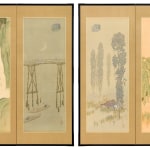Aida Naohiko
Scenes of the Twelve Months, circa 1915-25
Twelve paintings mounted as a pair of six-panel folding screens; ink, mineral colors, and gofun on silk
Size each screen 55 x 127 in. (140 x 322.5 cm)
Size each painting 44 x 16 in. (112 x 40.5 cm)
Size each painting 44 x 16 in. (112 x 40.5 cm)
T-4492
Further images
-
(View a larger image of thumbnail 1
)

-
(View a larger image of thumbnail 2
)

-
(View a larger image of thumbnail 3
)

-
(View a larger image of thumbnail 4
)

-
(View a larger image of thumbnail 5
)

-
(View a larger image of thumbnail 6
)

-
(View a larger image of thumbnail 7
)

-
(View a larger image of thumbnail 8
)

-
(View a larger image of thumbnail 9
)

-
(View a larger image of thumbnail 10
)

-
(View a larger image of thumbnail 11
)

-
(View a larger image of thumbnail 12
)

-
(View a larger image of thumbnail 13
)

-
(View a larger image of thumbnail 14
)

-
(View a larger image of thumbnail 15
)

-
(View a larger image of thumbnail 16
)

-
(View a larger image of thumbnail 17
)

-
(View a larger image of thumbnail 18
)

-
(View a larger image of thumbnail 19
)

-
(View a larger image of thumbnail 20
)

-
(View a larger image of thumbnail 21
)

Well-known as a Western-style watercolorist, Aida Naohiko here adopts Japanese conventions and a vertical East-Asian format to depict a series of twelve charming, delicate, and atmospheric landscape subjects, each of...
Well-known as a Western-style watercolorist, Aida Naohiko here adopts Japanese conventions and a vertical East-Asian format to depict a series of twelve charming, delicate, and atmospheric landscape subjects, each of them related to a particular month of the year and labeled with a cartouche in the form of two overlapping squares of Japanese paper. Some paintings in the series recall the work of painters in the neo-Rinpa style pioneered by Kyoto-based artist and art director Kamisaka Sekka (1866–1942).
Born in Aizu-Wakamatsu, some 200 miles north of Tokyo, Aida Naohiko (known early in his career as Torahiko 寅彦) exhibited regularly at the Bunten official national salon and its successors from 1909 until 1943, eventually reaching mukansa status (free from the requirement to submit his work for selection) and serving as a jury member. He was a member or founder-member of several leading associations devoted to watercolors or Western-style painting, including the Nihon Suisaigakai, the Hakujitsukai, the Hakubakai, and the Taiheiyōgakai.
The twelve scenes are as follows, from right to left:
First Month: Sunrise on New Year’s Day
Second Month: Mountain Home in the Snow
Third Month: Plum-Blossom Village
Fourth Month: Cherry Blossom in the Mountains
Fifth Month: In the Willow's Shade
Sixth Month: The Scent of Flowers
Seventh Month: Evening Cool
Eighth Month: Waterfall Deep in the Mountains
Ninth Month: Rainstorm
Tenth Month: Evening Moon
Eleventh Month: Pasture
Twelfth Month: Withered Grasses in the Mountains
Born in Aizu-Wakamatsu, some 200 miles north of Tokyo, Aida Naohiko (known early in his career as Torahiko 寅彦) exhibited regularly at the Bunten official national salon and its successors from 1909 until 1943, eventually reaching mukansa status (free from the requirement to submit his work for selection) and serving as a jury member. He was a member or founder-member of several leading associations devoted to watercolors or Western-style painting, including the Nihon Suisaigakai, the Hakujitsukai, the Hakubakai, and the Taiheiyōgakai.
The twelve scenes are as follows, from right to left:
First Month: Sunrise on New Year’s Day
Second Month: Mountain Home in the Snow
Third Month: Plum-Blossom Village
Fourth Month: Cherry Blossom in the Mountains
Fifth Month: In the Willow's Shade
Sixth Month: The Scent of Flowers
Seventh Month: Evening Cool
Eighth Month: Waterfall Deep in the Mountains
Ninth Month: Rainstorm
Tenth Month: Evening Moon
Eleventh Month: Pasture
Twelfth Month: Withered Grasses in the Mountains




















